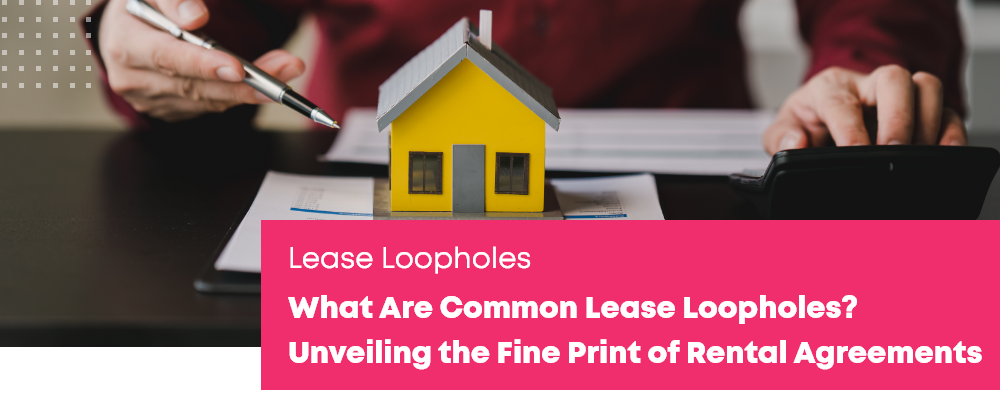What Are Common Lease Loopholes? Unveiling the Fine Print of Rental Agreements
Introduction
When entering into a rental agreement, tenants often focus on the major terms and conditions but overlook the fine print. Rental agreements are legally binding contracts that outline the rights and responsibilities of both landlords and tenants. However, hidden within the lease may be certain loopholes that can potentially impact tenants’ rights and financial obligations. In this blog post, we will explore some common lease loopholes that tenants should be aware of before signing a rental agreement. Understanding these loopholes will empower tenants to make informed decisions and protect their interests throughout the duration of their tenancy.
Security Deposit and Move-In Fees:
One common lease loophole relates to security deposits and move-in fees. While it is standard for landlords to require a security deposit to cover any damages or unpaid rent, some landlords may exploit this provision. Tenants should carefully review the lease to ensure it specifies the conditions under which the security deposit will be refunded and the timeframe for doing so. Additionally, landlords may try to impose excessive move-in fees that go beyond covering necessary costs. Being aware of the permissible limits and understanding state laws regarding security deposits and move-in fees can help tenants avoid potential financial pitfalls. It’s essential for tenants to document the condition of the rental unit upon move-in through photos or a move-in checklist to protect themselves from unfair deductions from the security deposit.
Maintenance and Repairs:
Lease agreements typically outline the responsibilities of landlords and tenants when it comes to maintenance and repairs. However, some leases may contain loopholes that unfairly burden tenants with maintenance costs. For example, a lease might shift the responsibility of certain repairs to tenants, even if they are not responsible for the damage. Tenants should carefully review the lease to understand the extent of their maintenance obligations and ensure that they are not being held accountable for pre-existing damages or general wear and tear. Additionally, tenants should be aware of any clauses that require them to use specific vendors for repairs, as this may limit their options and potentially result in higher costs. It’s important for tenants to promptly report any maintenance issues to the landlord or property management company to ensure timely repairs and avoid being held responsible for damages that are the landlord’s responsibility.
Lease Renewal and Rent Increases:
Lease renewal and rent increase provisions can also contain loopholes that tenants need to be mindful of. Some leases may include automatic lease renewal clauses, which can catch tenants off guard if they do not wish to continue their tenancy. To avoid inadvertently extending the lease term, tenants should understand the renewal process and any necessary notification requirements. Rent increase clauses are another area where tenants should be cautious. While rent increases are not uncommon, some leases may allow for excessive or unregulated increases. Tenants should carefully review the lease for provisions that outline how and when rent increases can occur, ensuring they align with local rent control laws and fair market practices. Tenants may consider negotiating a cap on rent increases or a more predictable rent escalation schedule to avoid unexpected financial burdens.
Early Termination and Subletting:
Lease agreements often include provisions regarding early termination and subletting. Tenants should be aware of the conditions and potential penalties associated with breaking a lease before its expiration date. Some leases may require tenants to pay several months’ worth of rent as a penalty for early termination, while others may offer more reasonable options, such as finding a replacement tenant. Additionally, subletting clauses can be restrictive, limiting tenants’ ability to sublet their rental unit. Tenants should review the lease carefully to understand the terms and seek clarification from their landlord if needed. It’s advisable for tenants to communicate openly with the landlord if they anticipate needing to terminate the lease early or explore subletting options, ensuring compliance with the lease terms and local regulations.
Conclusion:
Understanding the common lease loopholes discussed in this blog post empowers tenants to be vigilant and protect their rights and financial interests. By carefully reviewing the lease agreement, tenants can identify potential pitfalls and negotiate terms that align with their needs. It is crucial for tenants to consult with legal professionals or tenant advocacy organizations to ensure their rights are adequately protected. By staying informed and proactive, tenants can navigate rental agreements with confidence and secure a positive rental experience. Remember, knowledge is key when it comes to unraveling the fine print of rental agreements and safeguarding your rights as a tenant. Optivo Group believes that knowledge is key in unraveling the fine print of rental agreements, allowing tenants to secure a positive and rewarding rental experience.
